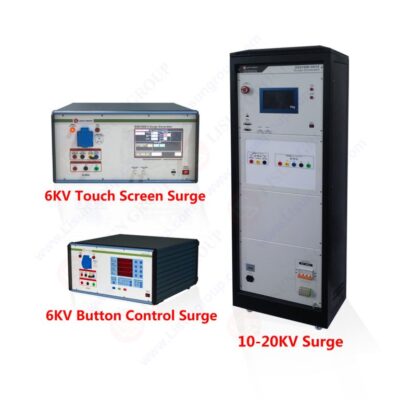

As technology advances and electronic devices become more ubiquitous, the impact of lightning surges on electronic equipment is garnering increasing attention. Lightning surges, which refer to transient overvoltages or overcurrents caused by lightning activity on power or signal lines, can cause severe damage to devices. This article explores the effects of lightning surges on electronic equipment and how to effectively protect against them.
1. Generation and Characteristics of Lightning Surges
Lightning surges typically occur within an extremely short time frame, often in the microsecond range or even shorter. This transient phenomenon causes voltage and current levels to exceed the normal operating levels of the equipment by more than double. Due to their rapid onset and quick dissipation, lightning surges can inflict damage on equipment in a very brief period. During a surge, the input filter capacitor charges rapidly, leading to peak currents far exceeding the steady-state input current, placing immense stress on the power supply and other critical components.
2. Effects of Lightning Surges on Electronic Devices
• Voltage Fluctuations and Equipment Damage
Lightning surges can cause severe voltage fluctuations, leading to abnormal behavior in electronic devices. Common issues include: machinery stopping or starting unexpectedly, control systems frequently resetting, and premature aging or damage to motors and other electrical components due to excessive current surges. Additionally, surges can lead to breakdowns in semiconductor device voltages, damage to metallization layers on components, or even destruction of printed circuit board (PCB) traces and contacts, ultimately resulting in complete equipment failure.
• Data Transmission and Processing Interference
Besides hardware damage, lightning surges can interfere with data processing and transmission. This can result in partial corruption of data files, errors in data processing programs, and unstable communication signal reception or transmission, significantly reducing system reliability and stability. In severe cases, surges may even cause permanent equipment failures.
• Reduced Equipment Lifespan
Repeated impact from lightning surges accelerates the aging of internal components, significantly shortening the overall lifespan of the equipment. This not only increases maintenance and replacement costs but can also affect the operational efficiency of the equipment.
3. Protective Measures and Best Practices
• Installation of Surge Protectors
Surge protectors are effective devices designed to quickly absorb excessive voltage or current during a lightning surge, protecting electronic equipment from damage. It is recommended to install high-quality surge protectors on critical power and signal lines to ensure equipment safety.
• Optimizing Power Design
During the design phase, effective power planning and filter circuit design can reduce the impact of lightning surges on equipment. For instance, using higher-rated fuses and rectifiers can enhance the surge tolerance of the equipment.
• Regular Inspection and Maintenance
For equipment vulnerable to lightning surges, regular inspection of power and signal lines is essential. Timely replacement of aging components and wiring ensures the equipment remains in optimal operating condition.
4. Testing Methods for Surge Testers
Surge testers are designed to simulate lightning and switching transients that can cause instantaneous large impacts on electrical equipment. To standardize this testing process, the International Electrotechnical Commission (IEC) has established the IEC 61000-4-5 standard, which outlines detailed requirements for surge immunity testing.
According to the IEC 61000-4-5 standard, surge testers typically simulate the following waveforms:
• 1.2/50µs Voltage Waveform: This waveform simulates voltage transients caused by lightning strikes, representing the typical characteristics of lightning voltage waveforms.
• 8/20µs Current Waveform: A rapidly rising current waveform used to simulate switching transients in power systems.
Combination Waveforms: Including 10/700µs voltage waveforms and 5/320µs current waveforms, these combination waveforms are used for more complex surge simulation scenarios.
During testing, surge testers precisely couple these waveforms into the test circuit through coupling/decoupling networks, assessing the equipment’s surge immunity in real-world applications. The goal is to determine whether the equipment can maintain normal operation under various surge intensities or how its functionality and performance change after a surge.
Surge generator_SG61000-5
5. Surge Tester Testing Levels
To scientifically assess the equipment’s surge immunity under different environmental conditions, surge tester testing levels are categorized based on varying voltage severity. These levels are classified from low to high as Levels 1, 2, 3, 4, and X, each corresponding to different voltage strengths and applicable scenarios. The classification is as follows:
• Level 1: Excellent Protection Environment
Suitable for environments with good electromagnetic protection, such as factory or power station control rooms. In these settings, electromagnetic interference is minimal, and the probability of surge occurrence is low.
• Level 2: Moderately Protected Environment
Applicable to ordinary factory settings with minimal interference sources. Although electromagnetic interference is low, there is still a possibility of mild surge impacts.
• Level 3: Typical Electromagnetic Interference Environment
Appropriate for industrial locations, standard cable networks, and substations without special electromagnetic interference protection. Equipment in these environments may frequently encounter general electromagnetic interference.
• Level 4: Severe Interference Environment
Designed for environments with high exposure to lightning or strong electromagnetic interference, such as unprotected high-voltage substations or overhead lines. Equipment in these conditions requires robust surge protection.
• Level X: Special Level
An open level where specific surge testing standards are determined through mutual agreement between users and manufacturers. This level is used for unconventional applications with customized testing conditions based on specific requirements.
6. Selection Criteria for Testing Levels
The choice of surge tester testing level primarily depends on the installation environment of the equipment and the potential frequency and intensity of surges. For enclosed environments like control rooms and data centers, lower testing levels are typically used. Conversely, for outdoor or lightning-prone areas, higher testing standards are required. Ultimately, the specific testing level for equipment is usually determined based on its applicable product standards.
Conclusion
Surge testers are crucial tools in assessing the surge immunity of electrical and electronic devices. By adhering to the IEC 61000-4-5 standard and selecting appropriate testing levels, one can effectively evaluate equipment performance under surge conditions, ensuring stability and safety in practical applications. https://www.lisungroup.com/news/technology-news/the-profound-impact-of-lightning-surges-on-electronic-devices-and-protective-measures.html


Comments
Post a Comment